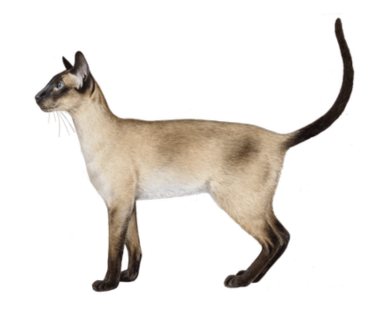Siamese
About the Breed
Long considered the personification of feline elegance, the Siamese has been the inspiration, if not the direct genetic source, for so many other breeds that it is universally considered one of the greatest treasures of the cat fancy. Indeed, the cat fancy as we know it today would likely not exist without the discovery and promotion of these exquisite cats by early English fanciers in the late 1880s. The striking contrast between the darker points and the paler body color, enhanced by the dramatic beauty of those sapphire blue eyes, has now exemplified the look of the pedigreed cat for well over a century.
Breed History
These cats were first documented in a historic Thai collection of cat poems written during the in the Ayutthaya period of Thai history (1350-1767). The first Siamese to arrive in the United States was “Siam,” given to President Rutherford B. Hayes by the American Consul in Bangkok in 1878. At the same time, Siamese were appearing in catalogues of the Crystal Palace cat shows and capturing the hearts of British cat lovers. More Siamese soon crossed the Atlantic, expanding their conquest to the fast-growing American cat fancy and becoming one of the first breeds recognized by CFA at its founding in 1906. The first Siamese Best-in-Show winner came just one year later. At the time, seal points—still the most popular—were the only color, but the other three traditional colors gradually followed. The blue point was recognized in 1934, the chocolate point in 1952 and the lilac point in 1955.
GENERAL
The ideal Siamese is a medium sized, svelte, refined cat with long tapering lines, very lithe but muscular. Males may be proportionately larger. Balance and refinement are the essence of the breed, where all parts come together in a harmonious whole, with neither too much nor too little consideration given to any one feature.
HEAD
Long tapering wedge. Medium in size in good proportion to body. The total wedge starts at the nose and flares out in straight lines to the tips of the ears forming a triangle, with no break at the whiskers. No less than the width of an eye between the eyes. When the whiskers are smoothed back, the underlying bone structure is apparent. Allowance must be made for jowls in the stud cat.
SKULL
Flat. In profile, a long straight line is seen from the top of the head to the tip of the nose. No bulge over eyes. No dip in nose.
EARS
Strikingly large, pointed, wide at base; continuing the lines of the wedge.
EYES
Almond shaped. Medium size. Neither protruding nor recessed. Slanted towards the nose in harmony with lines of wedge and ears. Uncrossed.
NOSE
Long and straight. A continuation of the forehead with no break.
MUZZLE
Fine, wedge-shaped.
CHIN and JAW
Medium size. Tip of chin lines up with tip of nose in the same vertical plane. Neither receding nor excessively massive.
BODY
Medium size. Graceful, long, and svelte. A distinctive combination of fine bones and firm muscles. Shoulders and hips continue same sleek lines of tubular body. Hips never wider than shoulders. Abdomen tight.
NECK
Long and slender.
LEGS
Long and slim. Hind legs higher than front. In good proportion to body.
PAWS
Dainty, small, and oval. Toes: five in front and four behind.
TAIL
Long, thin, tapering to a fine point.
COAT
Short, fine textured, glossy. Lying close to body.
CONDITION
Excellent physical condition. Eyes clear. Muscular, strong, and lithe. Neither flabby nor boney. Not fat.
COLOR
Body: even, with subtle shading when allowed. Allowance should be made for darker color in older cats as Siamese generally darken with age, but there must be definite contrast between body color and points. Points: mask, ears, legs, feet, tail dense and clearly defined. All of the same shade. Mask covers entire face including whisker pads and is connected to ears by tracings. Mask should not extend over the top of the head. No ticking or white hairs in points.
PENALIZE
Improper (i.e., off-color or spotted) nose leather or paw pads. Soft or mushy body. Visible protrusion of the cartilage at the end of the sternum under normal handling.
DISQUALIFY
Any evidence of illness or poor health. Weak hind legs. Mouth breathing due to nasal obstruction or poor occlusion. Emaciation. Visible kink. Eyes other than blue. White toes and/or feet. Incorrect number of toes. Malocclusion resulting in either undershot or overshot chin. Longhair.
SEAL POINT: body even pale fawn to cream, warm in tone, shading gradually into lighter color on the stomach and chest. Points deep seal brown. Nose leather and paw pads: same color as points. Eye color: deep vivid blue.
CHOCOLATE POINT: body ivory with no shading. Points milk-chocolate color, warm in tone. Nose leather and paw pads: cinnamon-pink. Eye color: deep vivid blue.
BLUE POINT: body bluish white, cold in tone, shading gradually to white on stomach and chest. Points deep blue. Nose leather and paw pads: slate colored. Eye color: deep vivid blue.
LILAC POINT: body glacial white with no shading. Points frosty grey with pinkish tone. Nose leather and paw pads: lavender-pink. Eye color: deep vivid blue.




